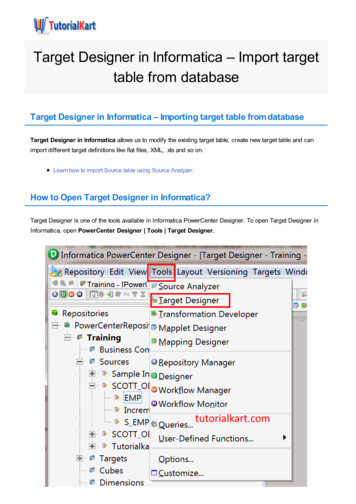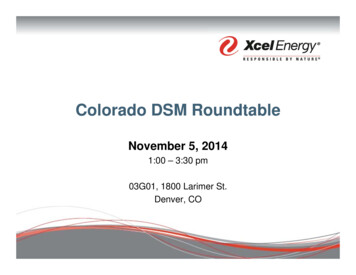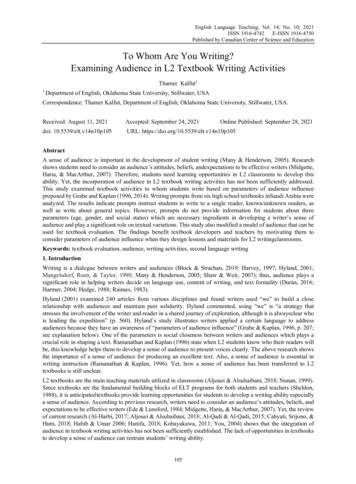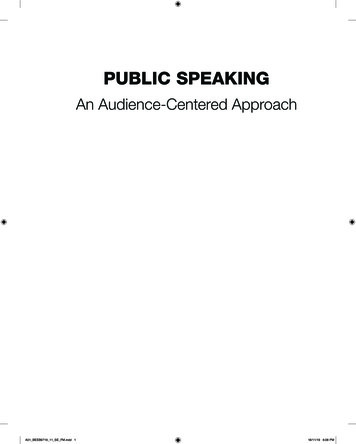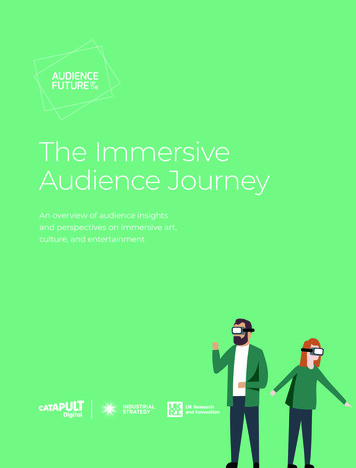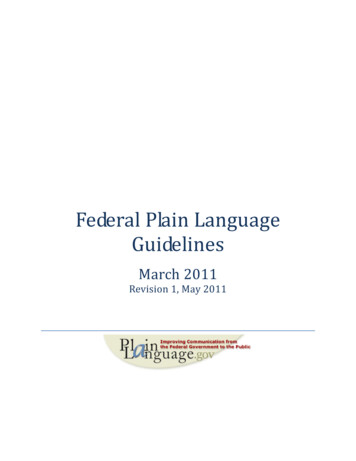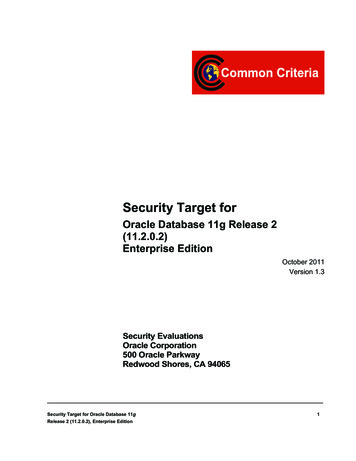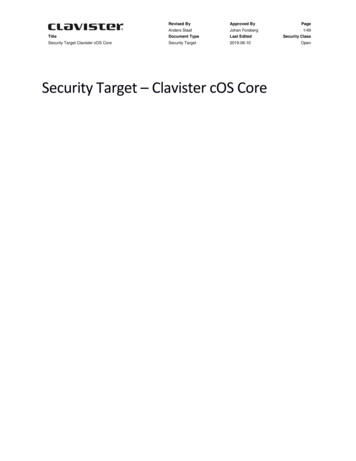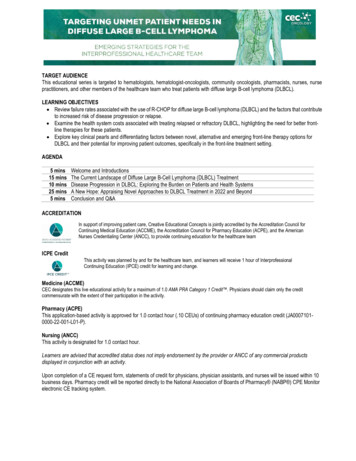
Transcription
TARGET AUDIENCEThis educational series is targeted to hematologists, hematologist-oncologists, community oncologists, pharmacists, nurses, nursepractitioners, and other members of the healthcare team who treat patients with diffuse large B-cell lymphoma (DLBCL).LEARNING OBJECTIVES Review failure rates associated with the use of R-CHOP for diffuse large B-cell lymphoma (DLBCL) and the factors that contributeto increased risk of disease progression or relapse. Examine the health system costs associated with treating relapsed or refractory DLBCL, highlighting the need for better frontline therapies for these patients. Explore key clinical pearls and differentiating factors between novel, alternative and emerging front-line therapy options forDLBCL and their potential for improving patient outcomes, specifically in the front-line treatment setting.AGENDA5 mins15 mins10 mins25 mins5 minsWelcome and IntroductionsThe Current Landscape of Diffuse Large B-Cell Lymphoma (DLBCL) TreatmentDisease Progression in DLBCL: Exploring the Burden on Patients and Health SystemsA New Hope: Appraising Novel Approaches to DLBCL Treatment in 2022 and BeyondConclusion and Q&AACCREDITATIONIn support of improving patient care, Creative Educational Concepts is jointly accredited by the Accreditation Council forContinuing Medical Education (ACCME), the Accreditation Council for Pharmacy Education (ACPE), and the AmericanNurses Credentialing Center (ANCC), to provide continuing education for the healthcare teamICPE CreditThis activity was planned by and for the healthcare team, and learners will receive 1 hour of InterprofessionalContinuing Education (IPCE) credit for learning and change.Medicine (ACCME)CEC designates this live educational activity for a maximum of 1.0 AMA PRA Category 1 Credit . Physicians should claim only the creditcommensurate with the extent of their participation in the activity.Pharmacy (ACPE)This application-based activity is approved for 1.0 contact hour (.10 CEUs) of continuing pharmacy education credit (JA00071010000-22-001-L01-P).Nursing (ANCC)This activity is designated for 1.0 contact hour.Learners are advised that accredited status does not imply endorsement by the provider or ANCC of any commercial productsdisplayed in conjunction with an activity.Upon completion of a CE request form, statements of credit for physicians, physician assistants, and nurses will be issued within 10business days. Pharmacy credit will be reported directly to the National Association of Boards of Pharmacy (NABP ) CPE Monitorelectronic CE tracking system.
Faculty DisclosureIt is the policy of Creative Educational Concepts, LLC, (CEC) to ensure independence, balance, objectivity, and scientific rigor andintegrity in all their CME/CE activities. Activity planners, faculty, peer reviewers, and CEC staff must disclose to the participants anyrelationships with ineligible entities whose products or devices may be mentioned in this CE activity, or with the commercial supporterof this CE activity. An ineligible entity is defined as any entity producing, marketing, re-selling, or distributing health care goods orservices consumed by, or used on, patients. Financial relationships may include research grants, consultant fees, travel, advisoryboards, consultancy, speakers’ bureaus, other benefits, or having a self-managed equity interest in a company.CEC has evaluated, identified, and mitigated any potential conflicts of interest through a rigorous content validation procedure, use ofevidence-based data/research, and a multidisciplinary peer review process. The following information is for participant information only.It is not assumed that these relationships will have a negative impact on the presentations.PlannersAmy L. Goodrich, RN, MSN, CRNP-AC-has disclosed that she is a consultant for Abbvie, AstraZeneca, BeiGene, Epizyme,Genentech, Pharmacyclics, Sanofi, and Seagen.Elizabeth A. Travers, PharmD, BCOP–has no relevant financial relationships to disclose in relation to the content of this activity.John Allan, MD–has disclosed that he is a consultant for Abbvie, AstraZeneca, BeiGene, Epizyme, Genentech, Janssen, and PCYC;receives grant/research support from BeiGene, Celgene, Genentech, Janssen, and TG Therapeutics. He is also a member of thespeakers’ bureau for Abbvie, BeiGene, and PCYC/Janssen.PresenterLoretta J. Nastoupil, MD- has disclosed that she is a consultant for ADC therapeutics, Bayer, BMS/Celgene, Genentech, Epizyme,Janssen, Gilead, Morphosys and Novartis. She receives grant/research support from BMS/Celgene, Genentech, Epizyme, Gilead,Genentech, Novartis, Janssen, Pfizer and TG Therapeutics.Peer ReviewJeanie Patrick, PharmD–has no relevant financial relationships to disclose in relation to the content of this activity.Lisa Shotyk, RN, MSN, APN-BC–has no relevant financial relationships to disclose in relation to the content of this activity.CEC Staff:Tina L. Trieu, PharmD–has no relevant financial relationships to disclose in relation to the content of this activity.Ashley C. Lilly, MHA–has no relevant financial relationships to disclose in relation to the content of this activity.PRESENTED BYCreative Educational Concepts, LLCSupported through an independent educational grant from Genentech.
1Disclaimer This slide deck in its original and unaltered format is for educational purposes and is currentas of the date of this presentation. All materials contained herein reflect the views of thefaculty, and not those of Creative Educational Concepts, LLC. or the commercial supporter(s). Participants have an implied responsibility to use the newly acquired information to enhancepatient outcomes and their own professional development. The information presented in thisactivity is not meant to serve as a guideline for specific patient management. Any procedures, medications, or other courses of diagnosis or treatment discussed orsuggested in this activity should not be used by clinicians without evaluation of their patient’sconditions and possible contraindications on dangers in use, review or any applicablemanufacturer’s product information, and Comparison with recommendations of otherauthorities. Usage Rights: This slide deck is provided for educational purposes and individual slides maybe used for personal, non-commercial presentations only if the content and referencesremain unchanged. No part of this slide deck may be published or distributed in print orelectronic format without prior written permission from Creative Educational Concepts, LLC. Additional terms and conditions may apply.21
Objectives Review failure rates associated with the use of R-CHOP for diffuselarge B-cell lymphoma (DLBCL) and factors that contribute to therisk of disease progression or relapse. Discuss health system costs associated with treating relapsed orrefractory DLBCL. Evaluate alternative front-line therapy options for DLBCL and theirimpact on patient outcomes. Explore emerging front-line therapies for DLBCL.7The Current Landscape of Diffuse LargeB-cell Lymphoma (DLBCL) Treatment132
Diffuse Large B-cell Lymphoma Diffuse large B-cell lymphoma (DLBCL) is the mostcommon non-Hodgkin lymphoma (NHL), representingalmost 30% of NHL cases worldwide There are approximately 150,000 new cases of DLBCLdiagnosed annually Patients commonly present with progressivelymphadenopathy and extranodal disease requiringaggressive treatment with immunochemotherapySehn LH, Salles G. N Engl J Med. 2021.14R-CHOPFor nearly 20 years, rituximab cyclophosphamide, doxorubicin,vincristine, and prednisone (R-CHOP) has been the standard firstline treatment for DLBCL.A Typical Regimen of Rituximab with Cyclophosphamide, Doxorubicin, Vincristine, and Prednisone (R-CHOP)DrugDoseRituximabIntravenous infusion (375 mg/m2 of body-surface area) on day 1CyclophosphamideIntravenous bolus (750 mg/m2) on day 1DoxorubicinIntravenous bolus (50 mg/m2) on day 1VincristineIntravenous bolus (1.4 mg/m2) on day 1PrednisoneOral administration (100 mg) on days 1–5Nowakowski GS. Clin Adv Hematol Oncol. 2021; Maloney DG. N Engl J Med. 2012.153
R-CHOP as Standard of Care The GELA study evaluated the benefit of the addition of rituximabto CHOP chemotherapy in elderly patients (60 to 80 years old)with diffuse large B-cell lymphoma Response rates for R-CHOP and CHOP were: CR/CRu 75% and 63%, PD 9%and 22%, and death during treatment 6% and 6%, respectively (P .005) The MInT study showed improved 3-year outcomes with theaddition of rituximab to a CHOP like regimen in young patientswith good-prognosis diffuse large-B-cell lymphoma 6-year event-free survival was 55.8% for patients assigned tochemotherapy alone and 74.3% for those assigned to chemotherapyplus rituximab (p 0·0001)Coiffier B, et al. N Engl J Med. 2002; Pfreundschuh M, et al. Blood. 2004; NCCN Guidelines. B-cell Lymphomas. v2.2022;Persky DO, et al. J Clin Oncol. 2008; Pfreundschuh M, et al. Lancet Oncol. 2008; Pfreundschuh M, et al. J Clin Oncol. 2011.17R-CHOP as Standard of Care For patients with limited stage disease, S1001 found that 4cycles of R-CHOP alone was found to be as equally effectiveas 3 cycles of R-CHOP followed by radiation andradioimmunotherapy The 5-year progression-free survival estimate was 87% and theOS estimate was 89% with patients having similar outcomesbetween the two groups In the SWOG0014 study, 3 cycles of R-CHOP followed byinvolved-field radiation therapy (IFRT) in patients with atleast one adverse risk factor, the 4-year progression freesurvival (PFS) was 88% and the OS rate as 92%Coiffier B, et al. N Engl J Med. 2002; Pfreundschuh M, et al. Blood. 2004; NCCN Guidelines. B-cell Lymphomas. v2.2022;Persky DO, et al. J Clin Oncol. 2008; Pfreundschuh M, et al. Lancet Oncol. 2008; Pfreundschuh M, et al. J Clin Oncol. 2011.184
R-CHOP Failures Despite R-CHOP being our “gold standard” therapy for DLBCLsince 1976, only 50%–70% of patients receiving this regimenare cured R-CHOP is found to be inadequate in 30%–40% of patientswith diffuse large B-cell lymphoma with a 10-year OS rate ofapproximately 43.5% for patients with stage II–IV DLBCLreceiving R-CHOP alone There are two major distinct molecular subtypes of DLBCL:germinal center B-cell (GCB) and activated B-cell (ABC) ABC DLBCL is associated with substantially worse outcomestreated with standard chemoimmunotherapywhenNowakowski GS. Clin Adv Hematol Oncol. 2021; Coiffier B, Sarkozy C. Am Soc Hematol Educ Progr. 2016; Morrison VA. J Geriatr Oncol. 2021; Syed YA, et al. Cureus. 2021.19International Prognostic Index for DiffuseLarge B-cell Lymphoma (IPI and R-IPI)El-Galaly TC, et al. Am J Hematol. 2015; Olszewski AJ, et al. Cancer Causes Control. 2015; Bari A, et al. Ann Oncol. 2010.205
Risk Factors for Treatment Failurein the Front-Line Setting These treatment failures are due to a variety of patient- and cancerspecific factors Poor prognosis/response to treatment IPI Index GBC vs ABC subtype Death related to R-CHOP toxicities, although uncommon in youngerpatients, may be seen in up to 5% of patients 70 years of age This treatment-related mortality is usually associated with a lack ofresponse to chemotherapyMorrison VA. J Geriatr Oncol. 2021; Coiffier B, et al. Am Soc Hematol Educ Progr. 2016; Hans CP, et al. Blood. 2004.21Early vs Late Relapse Relapses can be defined as early or late Early relapses occurring within 2 years of diagnosis Late relapses occurring more than 2 years from diagnosis Response to salvage therapy is improved with relapsed 12months from diagnosis Patients who relapse within a year of initial therapy do poorly anddo not respond as well to salvage therapy Late-relapsing patients tend to have better responses tosalvage therapies than those with refractory disease or earlyrelapseKoh JJ, et al. J Clin Oncol. 2018; Morrison VA. J Geriatr Oncol. 2021.226
Early vs Late Relapse In a retrospective analysis of patients diagnosed with denovo DLBCL from 1992 to 2017, the odds of having anearly relapse as opposed to a late relapse (P 0.05 forall) was higher in patients with: High LDH (2.63 [1.57–4.42]) More than 1 extranodal site of disease (3.42 [2.56–5.43]) Stage 3 or 4 disease (8.82 [4.10–19])Koh JJ, et al. J Clin Oncol. 2018.23Double Hit Lymphomas Many patients with treatment failure have double-hitlymphomas Rearrangements of MYC and BCL2 and/or BCL6 genes Tumors with co-expression of MYC and BCL2 are associatedwith a poor prognosis and an aggressive clinical course These patients often receive R-EPOCHimmunochemotherapy as R-CHOP alone often is notadequate therapyMorrison VA. J Geriatr Oncol. 2021; Coiffier B, et al. Am Soc Hematol Educ Progr. 2016; NCCN Guidelines. B-cell Lymphoma. v2.2022; Hans CP, et al. Blood. 2004.247
GCB vs ABC Subtypes There are two major biologically distinct molecular subtypesof DLBCL Germinal center B-cell (GCB) and activated B-cell (ABC) GBC DLBCL is associated with improved outcomes comparedto ABC DLBCL in patients treated with R-CHOP Trials are ongoing to explore if novel targeted agents canimprove outcomes in ABC DLBCL Currently, the standard of care remains the same for both GCBand ABC subtypesNowakowski GS. Am Soc Clin Oncol Educ Book. 2015; NCCN. B-cell Lymphoma. v2.2022.25Disease Progression in DLBCLExploring the Burdenon Patients and Health Systems268
Overall Survival from Initiation of Salvage TherapyCrump M, et al. Blood Adv. 2017.27Outcomes of CAR T vs. Alternative TherapiesSermer D, et al. Blood Adv. 2020.289
Cost of Treating DLBCL The National Cancer Institute places lymphoma among the topfive cancers by U.S. national expenditure with an estimated 2018cost in excess of 14 billion Throughout all-cost studies, drug cost is consistently among themost significant contributors to overall DLBCL cost burden Of note, all DLBCL total-cost studies predate the FDA approval of CAR Tcells and polatuzumab Given the increased incidence of DLBCL and the new technologiesfor treating DLBCL, the rising cost of DLBCL continues to place asignificant financial burden on patients and the healthcare systemHarkins RA, et al. Expert Rev Pharmacoecon Outcomes Res. 2019.29Breakdown of Monthly Treatment Costs Optum claims database from 2008 to 2015 found treated DLBCL patients had a totalmonthly per patient cost of 11,890, of which 6,691 was DLBCL related 5,199 was non–DLBCL related Other studies have found similar per patient per month (PPPM) costs Optum claims information from 2007 to 2013 identified a mean total PPPM cost of 12,804 More recent U.S. MarketScan claims found higher overall costs with mean PPPM of 16,751 From first to second year following diagnosis, medical costs PPPM decreasedramatically as cured patients have a decreased need for chemotherapy (withadministration being a major contributor to total costs), inpatient admissions, andother outpatient servicesMorrison VA, et al. Future Oncol. 2018; Harkins RA, et al. Expert Rev Pharmacoecon Outcomes Res. 2019.3010
Total Cost of R-CHOP Therapy Estimates of mean total cost burden for patients receiving RCHOP as front-line therapy range from 27,659 to 69,633depending on timeframe in which the cost analysis wascompleted In these studies, the average drug cost for R-CHOP rangesfrom 14,543 to 28,726 In most evaluations of cost-effectiveness of R-CHOPcompared to CHOP, R-CHOP has been shown to be costeffective regardless of age group studiedHarkins RA, et al. Expert Rev Pharmacoecon Outcomes Res. 2019.31Cost of Disease Progression In patients requiring second-line therapy, treatment costs aresignificantly higher than those not experiencing relapse; indicatesa significant economic impact on failure of front-line therapy Truven Health MarketScan claims data between 2006 and 2015found 1,374 patients with DLBCL who received R-CHOP Yearly costs were higher in patients receiving second-line therapy (217)compared to those who received R-CHOP alone (1,157) Year 1: 210,488 vs 25,044 (P 0.001) Year 2: 267,770 vs 42,272 (P 0.001)Purdum A, et al. Oncologist. 2019.3211
Cost of CAR T-cell Therapy Another large driver in the cost of treating relapsed/refractory DLBCL isCAR T-cells as a third-line treatment option A 2020 study estimated the total costs associated with tisagenlecleuceltreatment in adult patients with relapsed DLBCL at a U.S. hospital The estimated overall cost 437,927/patient The top drivers of additional cost were: adverse reaction management ( 30,594; 47.2%), inpatient/ICU care ( 24,285;37.5%), and lab tests/procedures ( 5,443; 8.4%) Total costs ranged from 382,702 (patients with no adverse reactionswho did not require hospitalization) to 469,006 (patients with cytokinerelease syndrome and B-cell aplasia requiring prolonged hospitalization)Yang H, et al. J Med Econ. 2020.33A New HopeAppraising Novel Approachesto DLBCL Treatment in 2022 and Beyond3412
Standard DLBCL PopulationOutcome of Patients with DLBCL after R-CHOP Chemotherapy15%–25% are refractory to anychemotherapy5% PR patientsWe need randomized studies onthese selected groups ofpatients20%–30% relapses50%–60% are already curedwith previous chemotherapy(R-CHOP)We will never improvethose cure patientsCoiffier B, et al. Am Soc Hematol Educ Progr. 2016.35Failed Attempts In recent years, randomized clinical trials have attempted to improveinitial cure rates by adding novel targeted agents to R-CHOP in order toimprove outcomes for patients with DLBCL Agents studied include bortezomib and ibrutinib However, none of these agents have improved outcomes in thesepatients Dose-adjusted EPOCH (etoposide, prednisone, vincristine,cyclophosphamide, and doxorubicin) plus rituximab also has failed toimprove survival outcomes for patients with DLBCL in a phase IIIrandomized study (CALGB 50303)Wang L, et al. J Hematol Oncol. 2020; Offner F, et al. Blood. 2015; Younes A, et al. J Clin Oncol. 2019; Bartlett NL, et al. J Clin Oncol. 2019.3613
Additional Strategiesto Improve Front-line Cure RatesR-CHOP-14 vs R-CHOP-21LenalidomideConsolidative radiationIbrutinibOptimization of anti-CD20 agent PolatuzumabMaintenance TherapyWang L, et al. J Hemtol Oncol. 2020.37R-CHOP-14 vs R-CHOP-21Two phase III randomized trials have compared R-CHOP-14 vs RCHOP-21: In trial of 1,080 patients ( 18 years old), 2-year OS rates were 83% and81% for the R-CHOP-14 and R-CHOP-21 groups respectively (P 0.38) While both treatment options had similar OS and PFS rates, R-CHOP-14had higher rates of grade 3 and 4 thrombocytopenia In trial of 602 patients (60–80 years old), 3-year OS rates were 69%and 71% for R-CHOP-14 and R-CHOP-21 groups respectively (P 0.75) Grade 3–4 neutropenia was greater in R-CHOP-14, despite increased useof GCSF in the R-CHOP-14 group Dose intensification with R-CHOP has no impact on patient outcomesCunningham D, et al. Lancet. 2013; Delarue R, et al. Lancet Oncol. 2013.3814
R-CHOP-14 vs R-CHOP-21 A meta-analysis of seven trials (4073 patients) found noOS difference between R-CHOP-14 to R-CHOP-like-21 The rates of progression or death, complete response,treatment-related mortality, grade 3-4 infection, anddiscontinuation were similar between groupsVidal L, et al. Acta Oncol. 2016.39Consolidative Radiation The role of involved-field radiation therapy (IFRT) as consolidative therapy inadvanced stage DLBCL is not well defined NCCN recommends consideration of IFRT for certain patients with limited stage diseasewith abbreviated courses of R-CHOP or patientswith advanced state with bulky disease orisolated skeletal sites A retrospective study published in 2021 looked at 188 patients with newlydiagnosed stage III and IV DLBCL who had a complete response to systemicimmunochemotherapy R-CHOP was the most common regimen and was used in 79% of patients 68 patients (36%) received consolidative radiotherapy after systemictherapy while 120 patients (64%) received systemic therapy aloneNCCN Guidelines. B-cell Lymphomas. v2.2022; Syed YA, et al. Cureus. 2021.4015
Consolidative RadiationProgression-free Survival (PFS)Overall Survival (OS)Syed YA, et al. Cureus. 2021.41PET Directed Therapy for Limited-Stage DLBCL In S1001, 128 patients with non-bulky ( 10 cm) stage I/IIuntreated DLBCL received R-CHOP for 3 cycles and then had aninterim PET scan Patients with negative PET scan received 1 additional cycle of RCHOP. Patients with positive PET scan received IFRT followed byibritumomab tiuxetan 5-yr PFS estimate was 87% and OS estimate was 90% with iPETpos and iPET-neg pts having similar outcomes, showing thatomitting IFRT is effectivePersky O, et al. Blood. 2019.4216
Exploring Alternative Anti-CD20 Agents Obinutuzumab is ahumanized type II anti‐CD20monoclonal antibody thatwas FDA approved in 2013 It has greater direct cell deathinduction and antibody‐dependent cellularcytotoxicity compared torituximabMondello P, Mian M. Hematol Oncol. 2019; FDA Prescribing Information; Al-Sawaf O, et al. Drug Des Devel Ther. 2017.43GATHER Phase II Study The phase II GATHER study showed that obinutuzumab plus CHOP(G‐CHOP) is a safe and effective regimen for newly-diagnosedadvanced DLBCL (N 100) ORR: 82% (CR of 55%) mPFS: 48 months 3-year PFS: 72% G-CHOP was effective and had an acceptable safety profile in thefirst-line treatment of patients with advanced DLBCLSharman JP, et al. Leuk Lymphoma. 2018.4417
GOYAProgression-free SurvivalOverall SurvivalSehn LH, et al. J Hematol Oncol. 2020.46ROBUST Phase III Study The phase III ROBUST study compared lenalidomide plus R-CHOP(R2-CHOP) with R-CHOP in previously untreated activated B-cell–like (ABC) subtype DLBCL (n 285 per arm) A total of 570 patients with ABC-DLBCL (n 285 per arm) werestratified by International Prognostic Index score, age, and bulkydisease, and randomly assigned to R2-CHOP or placebo/R-CHOP The most common grade 3/4 adverse events for R2-CHOP versusR-CHOP were neutropenia (60% v 48%), anemia (22% v14%),thrombocytopenia (17% v 11%), and leukopenia (14% v 15%)Nowakowski GS, et al. J Clin Oncol. 2021.4718
ROBUST StudyThe primary end point of PFS was not met, with a hazard ratio of 0.85 (95% CI, 0.63–1.14)and P 0.29; median PFS has not been reached for either arm.Nowakowski GS, et al. J Clin Oncol. 2021.48Ibrutinib – Phase III Study Double-blind phase III study where patients were randomlyassigned at a one-to-one ratio to ibrutinib (560 mg per dayorally) plus R-CHOP or placebo plus R-CHOP A total of 838 patients were randomly assigned to ibrutinibplus R-CHOP (n 419) or placebo plus R-CHOP (n 419) 75.9% of evaluable patients had ABC subtype Ibrutinib plus R-CHOP did not improve EFS in the ITT (HR,0.934) or ABC subtype (HR, 0.949) populationYounes A, et al. J Clin Oncol. 2019.4919
Patients 60 yearsPatients 60 yearsYounes A, et al. J Clin Oncol. 2019.50PolatuzumabPolatuzumab vedotin isa CD79b-targetingantibody-drugconjugate approved forrelapsed/refractoryDLBCL in combinationwith bendamustine andrituximab.Tilly H, et al. ASH 2021. Abstract LBA-1; Sawalha Y, Maddocks K. Onco Targets Ther. 2020; FDA Prescribing Information.5120
POLARIX Phase III Study Phase III double-blind, randomized trial of pola-R-CHP vs R-CHOP in 879patients with previously untreated, intermediate-/high-risk DLBCL The 2-year PFS rate was 77% with pola-R-CHP vs 70% with R-CHOP There was no clinical or statistically significant difference in 2-year OS betweentreatment arms: 88.7% and 88.6% in pola-R-CHP vs R-CHOP, respectively Most common grade 3/4 AEs for pola-R-CHP vs R-CHOP wereneutropenia (28% vs 31%), febrile neutropenia (14% vs 8%), anemia(12% vs 8%) While febrile neutropenia was higher with pola-R-CHP, those who hadinfections of grade 3/4 were similarPola-R-CHP, polatuzumab vedotin, rituximab, cyclophosphamide, doxorubicin, and prednisone.Tilly H, et al. ASH 2021. Abstract LBA-1.52PolatuzumabTilly H, et al. N Engl J Med. 2022.5321
POLARGO Phase III Study Phase III randomized trial of polatuzumab vedotin plus rituximab,gemcitabine, and oxaliplatin (Pola-R-GemOx) in patients with R/R DLBCL Results from the safety run-in stage presented at ASCO 2022: 15 pts were enrolled and 11 (73%) pts received 4 cycles of Pola-R-GemOx Grade 3–4 AEs were reported in 5 (33%) pts: thrombocytopenia (20%) andneutropenia (13%) were the most common Two (13%) pts had serious AEs (Grade 3 febrile neutropenia and Grade 3infection [n 1 each]) Eight (53%) pts had Grade 1 or 2 PN; there were no cases of Grade 3 PN POLARGO is currently enrolling pts to receive Pola-R-GemOx vs RGemOxMatasar MJ, et al. J Clin Oncol. 2022.54Maintenance Therapy The role of maintenance therapy is well defined in othertypes of NHL, but it is less clear in DLBCL as 50%–70%patients are initially cured with front-line therapy Currently, lenalidomide maintenance after front-linetherapy is a 2B recommendation in the NCCN guidelinesfor patients 60–80 years of age; recommendation isbased on data from the phase III ReMARC trialNCCN Guidelines. B-cell Lymphomas. v2.2022; Coiffier B, et al. N Engl J Med. 2002.5522
REMARC Phase III Study Phase III randomized trial of lenalidomide maintenance or placeboin 650 DLBCL patients (60–80 years old) with CR or PR after firstline R-CHOP therapy mPFS: NR vs 89 months, lenalidomide and placebo, respectively PFS benefit was consistent among all subgroups OS was similar between treatment arms (HR 1.17; 95% CI, 0.9–1.6) Most common grade 3/4 AEs associated with lenalidomide vsplacebo maintenance were neutropenia (57% vs 22%), rash (5% vs1%), infections (8% vs 6%), and thrombocytopenia (2.5% vs 0.6%)Thieblemont C, et al. Blood. 2020.56REMARC TrialThieblemont C, et al. Blood. 2020.5723
Investigational Agents In addition to trialing new therapy combinations toimprove initial outcomes in front-line DLBCL, there areseveral novel experimental therapies being studied inthe front-line setting These therapies may provide alternative front-linetreatments to help improve patient outcomes and curerates58Glofitamab Glofitamab is a bispecific Tcell–engaging antibody with anovel 2:1 structure withbivalency for CD20 on B-cellsand monovalency for CD3 on Tcells It is currently being studied inR/R DLBCL and in front-line,high-risk DLBCLHutchings M, et al. J Clin Oncol. 2021;ClinicalTrials.gov. Identifier: NCT04914741; Killock D. Nat Rev Clin Oncol. 2021.5924
Glofitamab Study NP30179 is the first in-human phase I trial assessing glofitamab aftersingle dose of obinutuzumab pretreatment and glofitumab with ongoingco-administered glofitumab in R/R B-NHL 74% of 171 patients had R/R DLBCL; data for all glofitamab DLBCL cohortsincludes ORR: 41%; CR: 29% 57% of patients had grade 3 adverse events (31% were thought to be associatedwith glofitamab), most common were neutropenia (25%), thrombocytopenia (8%),anemia (8%), and CRS (4%) COALITION is an open label, phase Ib/II, parallel arm study evaluating thesafety and tolerability of varying doses of glofitamab with R-CHOP orpolatuzumab vedotin-RCHP for younger patients with higher-risk DLBCLHutchings M, et al. J Clin Oncol. 2021; Minson A, et al. Blood. 2021.60Glofitamab: Phase II Expansion Results All pts had DLBCL (DLBCL NOS, HGBCL, PMBCL, or trFL) and had received 2 priorregimens including 1 anti-(a) CD20 Ab and 1 anthracycline IV glofitamab was then given as step-up doses on Day (D) 1 (2.5mg) and D8 (10mg) ofC1 and at the target dose (30mg) on D1 of C2–12 (21-day cycles) The projected 12-month OS rate was 48%, and 92% of complete responders were alive These results are consistent with earlier Phase I data in 100 pts treated with glofitamab CRS occurred in 68% of pts and was primarily associated with the initial doses: Grade 1 (51%) Grade 2 (12%) Grade 3 (3%) Grade 4 (2%)Dickinson M, et al. J Clin Oncol. 2022.6125
Mosunetuzumab Mosunetuzumab is another bispecific T-cell engager thatredirects T-cells to malignant B-cells by binding to CD3on T-cells and CD20 on B-cells It has shown a promising efficacy and safety profile inrelapsed/refractory NHL Now being studied as first-line therapy in combination withCHOP (M-CHOP) for DLBCL in the ongoing GO40515(NCT03677141) studyPhillips TJ, et al. Blood. 2020.62GO40515 Phase I/II Study Phase I/II study of mosunetuzumab with CHOP (M-CHOP) in R/RNHL and newly-diagnosed DLBCL patients (36 patients withDLBCL); stage of disease ranged from II–IV ORR: 96%; CR: 85% (in DLBCL patients) Overall grade 3 AEs occurred in 86% of all patients; grade 3neutropenia occurred in 64% of DLBCL patients 53% of DLBCL patients had cytokine release syndrome events; allwere grade 1–2, occurred in cycle 1, and resolved withoutcomplications, discontinuations, or delays in treatmentPhillips TJ, et al. Blood. 2020.6326
CELESTIMO Phase III Trial Phase III trial evaluating the efficacy and safety of mosunetuzumab plus lenalidomideversus rituximab plus lenalidomide in patients with relapsed or refractory follicularlymphoma who have received 1 line of systemic therapy. Patients must have histologically documented CD20 FL (Grades 1–3a) requiringsystemic therapy and have received 1 prior line of systemic therapy The primary endpoint is progression-free survival (PFS) Secondary endpoints include investigator-assessed PFS, complete and objectiveresponse, overall survival, and safety The study started recruitment in 2021 and plans to enroll approx. 400 patients fromapproximately 16 countries and 150 sites globally The chemotherapy-free M-Len combination may represent a promising outpatienttherapy option for future management of patients with R/R 64Summary R-CHOP is found to be inadequate in 30%–40% ofpatients with DLBCL 10-year OS rate of 44% for patients with stage II–IV DLBCLreceiving R-CHOP alone In patients requiring second-line therapy, treatmentcosts in year one and year two were 210,488 and 267,770 respectively, indica
speakers' bureau for Abbvie, BeiGene, and PCYC/Janssen. Presenter . Loretta J. Nastoupil, MD- has disclosed that she is a consultant for ADC therapeutics, Bayer, BMS/Celgene, Genentech, Epizyme, Janssen, Gilead, Morphosys and . She receives grant/research support fNovartis rom BMS/Celgene, Genentech, Epizyme, Gilead,
